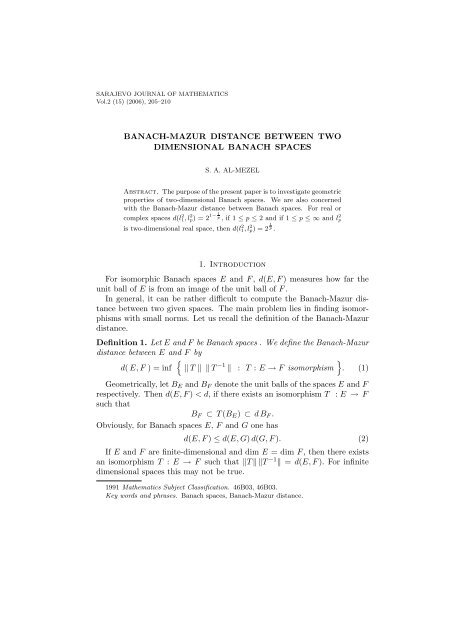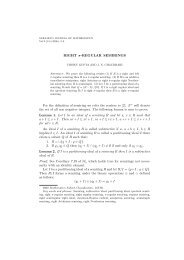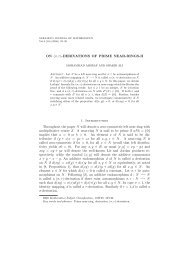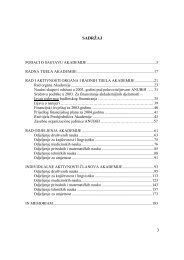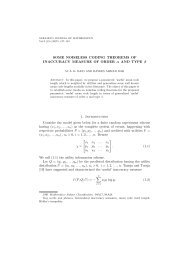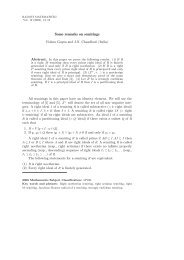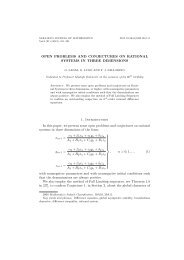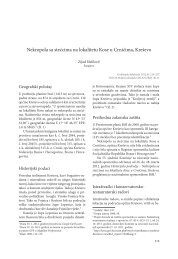BANACH-MAZUR DISTANCE BETWEEN TWO ... - anubih
BANACH-MAZUR DISTANCE BETWEEN TWO ... - anubih
BANACH-MAZUR DISTANCE BETWEEN TWO ... - anubih
You also want an ePaper? Increase the reach of your titles
YUMPU automatically turns print PDFs into web optimized ePapers that Google loves.
SARAJEVO JOURNAL OF MATHEMATICS<br />
Vol.2 (15) (2006), 205–210<br />
<strong>BANACH</strong>-<strong>MAZUR</strong> <strong>DISTANCE</strong> <strong>BETWEEN</strong> <strong>TWO</strong><br />
DIMENSIONAL <strong>BANACH</strong> SPACES<br />
S. A. AL-MEZEL<br />
Abstract. The purpose of the present paper is to investigate geometric<br />
properties of two-dimensional Banach spaces. We are also concerned<br />
with the Banach-Mazur distance between Banach spaces. For real or<br />
complex spaces d(l1, 2 lp) 2 = 2 1− p 1 , if 1 ≤ p ≤ 2 and if 1 ≤ p ≤ ∞ and lp<br />
2<br />
is two-dimensional real space, then d(l 2 1, l 2 p) = 2 1 p .<br />
1. Introduction<br />
For isomorphic Banach spaces E and F , d(E, F ) measures how far the<br />
unit ball of E is from an image of the unit ball of F .<br />
In general, it can be rather difficult to compute the Banach-Mazur distance<br />
between two given spaces. The main problem lies in finding isomorphisms<br />
with small norms. Let us recall the definition of the Banach-Mazur<br />
distance.<br />
Definition 1. Let E and F be Banach spaces . We define the Banach-Mazur<br />
distance between E and F by<br />
{<br />
}<br />
d( E, F ) = inf ‖ T ‖ ‖ T −1 ‖ : T : E → F isomorphism . (1)<br />
Geometrically, let B E and B F denote the unit balls of the spaces E and F<br />
respectively. Then d(E, F ) < d, if there exists an isomorphism T : E → F<br />
such that<br />
B F ⊂ T (B E ) ⊂ d B F .<br />
Obviously, for Banach spaces E, F and G one has<br />
d(E, F ) ≤ d(E, G) d(G, F ). (2)<br />
If E and F are finite-dimensional and dim E = dim F , then there exists<br />
an isomorphism T : E → F such that ‖T ‖ ‖T −1 ‖ = d(E, F ). For infinite<br />
dimensional spaces this may not be true.<br />
1991 Mathematics Subject Classification. 46B03, 46B03.<br />
Key words and phrases. Banach spaces, Banach-Mazur distance.
206 S. A. AL-MEZEL<br />
If E and F are not isomorphic, then one defines their Banach-Mazur<br />
distance to be infinity.<br />
Example 1. If E = (V, ‖ . ‖) is an n-dimensional normed space, then<br />
d(E, l n 1 ) ≤ n.<br />
In 1948 for finite dimensional spaces Fritz John [2] proved an essentially<br />
best-possible upper bound for d(E, F ) by first bounding the distance of an<br />
n-dimensional space from l2 n.<br />
The following theorem of John shows that<br />
one can obtain a good upper bound for d(E, l2 n ) be taking the ellipsoid<br />
D of minimal volume containing B E . An ellipsoid is the set of the form<br />
{x : 〈x, x〉 ≤ 1} for some inner product 〈., .〉 on R n .<br />
Theorem 1 (John’s theorem). Let E be a normed space with unit ball B E .<br />
Then there is a unique ellipsoid D of minimal (Euclidean) volume containing<br />
B E . Furthermore,<br />
n − 1 2 D ⊂ BE ⊂ D.<br />
In particular, d(E, l n 2 ) ≤ n 1 2 .<br />
Let E and F be n-dimensional normed spaces by Theorem 1. Then<br />
d(E, F ) ≤ d(E, l n 2 ) d(l n 2 , F ) ≤ n 1 2 n<br />
1<br />
2 = n.<br />
The following lemma was proved by J. Lamperti [3].<br />
Lemma 1. If x and y are complex numbers, then if<br />
If<br />
1 ≤ p < 2, then<br />
2 < p ≤ ∞, then<br />
|x + y| p + |x − y| p ≥ 2|x| p + 2|y| p . (3)<br />
|x + y| p + |x − y| p ≤ 2|x| p + 2|y| p . (4)<br />
For p = 2, of course, we get equality for any x and y .<br />
The two-dimensional real spaces l∞ 2 and l1 2 are isometric because the unit<br />
balls in both l∞ 2 and l1 2 are square. We can see that by rotating l2 1 into l2 ∞.<br />
Define a map T : l1 2 → l2 ∞ by<br />
( )<br />
(x + y)<br />
T (x, y) =<br />
.<br />
(x − y)<br />
Then T is an isometry, since max(|x + y|, |x − y|) = |x| + |y|, for all x, y ∈ R.<br />
But in three-dimensional spaces l∞ 3 and l1 3 are not isometric because the unit<br />
balls in both l∞ 3 and l1 3 are different, the unit ball in l3 1 is octahedron while<br />
the unit ball in l∞ 3 is a cube. From these results we calculate the Banach-<br />
Mazur distance between l1 2 and l2 p for the real (complex) two-dimensional<br />
spaces.
<strong>BANACH</strong>-<strong>MAZUR</strong> <strong>DISTANCE</strong> 207<br />
Theorem 2. Let lp 2 be the real or complex two-dimensional space. Then<br />
d(l1, 2 lp) 2 = 2 1− 1 p , for 1 ≤ p ≤ 2. (5)<br />
Proof. Let T : lp 2 → l1 2 be the identity map<br />
T : (x 1 , x 2 ) → (x 1 , x 2 ).<br />
By Holder’s inequality:<br />
|x 1 | + |x 2 | ≤ (1 q + 1 q ) 1 q (|x 1 | p + |x 2 | p ) 1 p<br />
= 2 1− 1 p ‖(x 1 , x 2 )‖ p . (6)<br />
But if x 1 = x 2 = 2 − 1 p ,<br />
‖x‖ = 1. Then<br />
‖T (x)‖ = ‖(x 1 , x 2 )‖ 1 = |x 1 | + |x 2 | = 2 1− 1 p . (7)<br />
Hence, ‖T ‖ = 2 1− 1 p . Next, we show that ‖ T −1 ‖ = 1.<br />
Let T −1 : l1 2 → l2 p and let y = (y 1 , y 2 ) ∈ l1 2, then ‖y‖ 1 = |y 1 | + |y 2 |. Since<br />
(|y 1 | p + |y 2 | p ) 1 p ≤ |y 1 | + |y 2 |, then ‖T −1 ‖ ≤ 1. But if y 1 = 1 and y 2 = 0, then<br />
‖T −1 y‖ 1 = 1 = ‖y‖ 1 . Therefore ‖T −1 ‖ = 1. Hence,<br />
d(l1, 2 lp) 2 ≤ 2 1− 1 p , for all p. (8)<br />
( )<br />
a b<br />
Let T = ∈ L(l<br />
c d<br />
1 2, l2 p) be an isomorphism with ‖T −1 ‖ = 1 such that<br />
a, b, c, d ∈ R or C and (e i ) be the unit vector in l1 2 , for i = 1, 2.<br />
We show that ‖T ‖ ≥ 2 1− 1 p<br />
( , ) when 1 ≤ p < 2 .<br />
ax1 + bx<br />
Then T (x 1 , x 2 ) =<br />
2<br />
and in particular<br />
cx 1 + dx 2<br />
( (<br />
a b<br />
T (e 1 ) = and T (e<br />
c)<br />
2 ) =<br />
(9)<br />
d)<br />
( )<br />
( )<br />
a + b<br />
a − b<br />
T (1, 1) = and T (1, −1) = .<br />
c + d<br />
c − d<br />
Since ‖T −1 ‖ = 1, ‖T (1, 1)‖ ≥ 2 and ‖T (1, −1)‖ ≥ 2 i.e.,<br />
Adding (10) and (11) we get that<br />
Therefore,<br />
|a + b| p + |c + d| p ≥ 2 p , (10)<br />
|a − b| p + |c − d| p ≥ 2 p . (11)<br />
|a + b| p + |a − b| p + |c + d| p + |c − d| p ≥ 2 p+1 .<br />
2|a| p + 2|b| p + 2|c| p + 2|d| p ≥ 2 p+1 , ( from (4) )
208 S. A. AL-MEZEL<br />
|a| p + |b| p + |c| p + |d| p ≥ 2 p .<br />
Then either |a| p + |c| p ≥ 2 p−1 or |b| p + |d| p ≥ 2 p−1 .<br />
In the first case ‖T (e 1 )‖ = ( |a| p + |c| p) 1 p<br />
≥ (2 p−1 ) 1 p = 2 1− 1 p .<br />
Similarly, the second case gives ‖T (e 2 )‖ ≥ 2 1− 1 p . Hence<br />
‖T ‖ ≥ 2 1− 1 p . (12)<br />
Therefore, d(l 2 1 , l2 p) = 2 1− 1 p , when 1 ≤ p ≤ 2.<br />
□<br />
In the next theorem, we calculate the Banach-Mazur distance between<br />
the real spaces l 2 1 and l2 p, when p ≥ 2.<br />
Theorem 3. Let l 2 p(2 ≤ p ≤ ∞) be two-dimensional real space. Then<br />
d(l 2 1, l 2 p) = 2 1 p .<br />
If l 2 p(p > 2) is the complex two-dimensional space. Then<br />
d(l 2 1, l 2 p) = √ 2.<br />
Proof. Since d(E, F ) = d(E ∗ , F ∗ ) we have that<br />
d(l 2 1, l 2 p) = d(l 2 ∞, l 2 q) where 1 p + 1 q = 1<br />
But l 2 ∞ is isometric to l 2 1 and so d(l2 ∞, l 2 q) = d(l 2 1 , l2 q) = 2 1− 1 q since q < 2.<br />
Therefore, d(l 2 1 , l2 p) = 2 1− 1 q = 2 1 p , for p ≥ 2.<br />
In the complex case, if we define T : l 2 1 → l2 p by<br />
Then<br />
(α, β) → (α + β, αβ).<br />
‖T (α, β)‖ p = ‖(α + β, α − β)‖ p = (|α + β| p + |α − β| p ) 1 p<br />
≤ (2(|α| + |β|) p ) 1 p<br />
= 2 1 p ‖(α, β)‖ p .<br />
Hence, ‖T ‖ ≤ 2 1 p . But if α = 1 and β = 0, then ‖T (α, β)‖ p = 2 1 p . Therefore,<br />
‖T ‖ = 2 1 p . (13)<br />
Now, T −1 : l 2 p → l 2 1 and (u, v) → ( 1<br />
2 (u + v), 1 2 (u − v)) .<br />
‖T −1 (u, v)‖ 1 = 1 2 |u + v| + 1 2 |u − v| ≤ (2)− 1 2<br />
(<br />
|u + v| 2 + |u − v| 2) 1 2
<strong>BANACH</strong>-<strong>MAZUR</strong> <strong>DISTANCE</strong> 209<br />
≤ (|u| 2 + |v| 2 ) 1 2 ≤ (2)<br />
1<br />
2<br />
( |u| p + |v| p<br />
2<br />
) 1<br />
p<br />
.<br />
Hence, ‖T −1 ‖ ≤ 2 1 2 − 1 p . But if (u, v) = (1, i), then<br />
‖ T −1 (1, i) ‖ 1 = 1 2 |1 + i| + 1 2 |1 − i| = 1 √ 1√ √<br />
2 + 2 = 2<br />
2 2<br />
and ‖(1, i)‖ p = 2 1 p . Therefore,<br />
‖T −1 ‖ = 2 1 2 − 1 p . (14)<br />
From (13) and (14) we deduce that ‖T ‖‖T −1 ‖ = 2 1 2 . □<br />
This suggests that d(l 2 1 , l2 p) = √ 2 for all p > 2. Estimates for d(l 2 1 , l2 p) are<br />
given in [5], but there the precise values in the complex case are not given.<br />
Now, we will estimate the Banach-Mazur distance between the spaces l 2 p<br />
and l 2 q.<br />
Lemma 2. Let 1 ≤ p ≤ q < 2, or 2 ≤ p ≤ q ≤ ∞, then d(l 2 p, l 2 q) = 2 1 p − 1 q .<br />
Proof. Let<br />
id : l 2 p → l 2 q denotes the identity operator. Then<br />
d(lp, 2 lq) 2 ≤ ‖ id ‖ ‖ id −1 ‖ = 2 1 p − 1 q . (15)<br />
Now we need to show that<br />
d(lp, 2 lq) 2 ≥ 2 1 p − 1 q .<br />
First, if 1 ≤ p ≤ q < 2, from Theorem 2 we have that<br />
d(l1, 2 lp) 2 = 2 1− 1 p and d(l1, 2 lq) 2 = 2 1− 1 q .<br />
Next using the property (2) one gets<br />
2 1− 1 q = d(l1, 2 lq) 2 ≤ d(l1, 2 lp) 2 d( lp, 2 lq 2 )<br />
It follows that<br />
2 1− 1 q ≤ d(l 2 p, l 2 q) 2 1− 1 p .<br />
2 1 p − 1 q ≤ d( l 2 p, l 2 q ).<br />
We have proved d( l 2 p, l 2 q ) = 2 1 p − 1 q .<br />
Second, if 2 ≤ p ≤ q ≤ ∞, from [5] we have<br />
Then<br />
d( l 2 2, l 2 p ) = 2 1 2 − 1 p and d( l 2 2, l 2 q ) = 2 1 2 − 1 q .<br />
2 1 2 − 1 q = d( l 2 2, l 2 q ) ≤ d( l 2 2, l 2 p ) d( l 2 p, l 2 q )
210 S. A. AL-MEZEL<br />
2 1 2 − 1 q ≤ 2 1 2 − 1 p d( l 2 q, l 2 p ).<br />
Hence d( l 2 p, l 2 q ) ≥ 2 1 p − 1 q , if 2 ≤ p ≤ q ≤ ∞. From (15) we deduce that<br />
d( l 2 p, l 2 q ) = 2 1 p − 1 q .<br />
□<br />
Acknowledgment. The results of this paper were obtained during my<br />
M.Phil [4] studies at Swansea University. The author also thanks the referee<br />
for his/her valuable suggestions for the improvement of this paper.<br />
References<br />
[1] H. Cohen, A Bound-two isomorphism between C(X) Banach spaces, Proc. Amer. Math.<br />
Soc., 50 (1975), 215–217.<br />
[2] F. John, Extreme problems with inqualities as subsidiary conditions , Courant Anniversary<br />
volume, (1948), 187–204, Interscience, New York.<br />
[3] J. Lamperti, On the isometries of certain function-spaces, Pacific J. Math., 8 (1958),<br />
459–466.<br />
[4] S. Al-mezel, Generalisation of the Banach-Stone theorem, M.Phil Thesis, Mathematics<br />
Department, University of Wales Swansea, United Kingdom, 2000.<br />
[5] V. E. Mazaev, V. E. Gurari and M. E. Kadec, On the distance between isomorphic<br />
L p spaces of finite dimension (Russian), Matematiceskii Sbornik 70 (112) 4 (1966),<br />
481–489.<br />
(Received: February 20, 2006)<br />
(Revised: July 8, 2006)<br />
Department of Mathematics<br />
King Abdulaziz University<br />
P.O.Box 80203<br />
Jeddah 21589, Saudi Arabia<br />
E–mail: mathsaleh@yahoo.com


